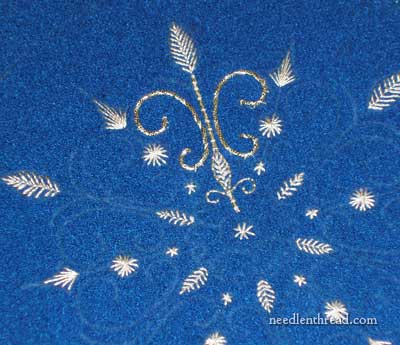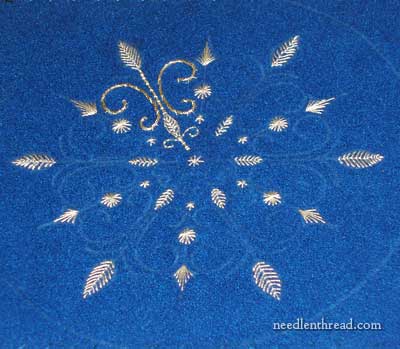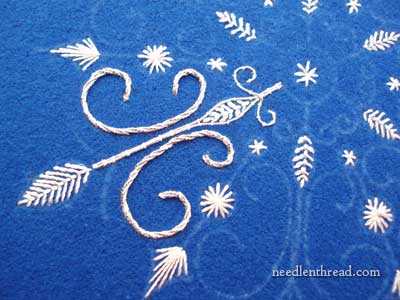This is a little update on the Silver, Silk, and Suede Embroidered Snowflake project.
There’s a little bit of silver on the snowflake, finally! With out-of-town company and Christmas preparations, I haven’t had a chance to do much stitching this week, but I did want to at least try the silver threads on this pseudo-suede fabric stuff. As it turns out, this is a tough kind of fabric for sinking real metal threads into, so I had a bit of a time with it! The outcome isn’t too reprehensible, but I’ll do things a bit differently in the next section and hopefully smooth out some of the rough spots.

I ended up using Au Ver a Soie’s Soie Surfine in white as the couching thread for the silver on this part of the snowflake. Since this whole project is a bit of a test run, I’ll be trying Soie 100/3 as well, in both white and silvery grey.
Sinking the thread ends to the back of the fabric was tough, even with the help of a plunging lasso. In fact, when I first plunged the ends, the entire metal thread shifted noticeably and pulled all the couching stitches out of whack. I really, really had to yank to get the thread through. After that, I used an awl to enlarge the hole a bit for plunging the threads, and that helped a little bit.

I’m using two metal threads here – the three-ply silver twist I mentioned a while back for the larger scroll areas and, for the arm between them, I’m using a silver passing thread.

The silver passing thread (the “arm” between the two heavier scrolls) is couched as a pair of threads, but I split it to go around the little feather part at the base of the arm. The tiny scrolls coming off the base of the arm are also silver passing thread, worked in a single line.
The silver and white on the blue is a nice combination – I like it a lot. What I don’t like is the ground fabric. It’s really a bear! But I’ll try a few different approaches to see if I can make it somewhat more manageable. The pseudo-suede, by the way, catches every bit of dust, every flake of beeswax from the couching thread – it is a magnet for every little visible tiny thing that can show up against the blue! It requires a bit of brushing off when it’s time to take a photo. The brushing really takes its toll on the design lines.
So, that’s the progress so far. I’m thinking that a velvet or velveteen would be a much better choice for the background fabric – live and learn, eh?
Tomorrow, I’ll post a printable version of the snowflake pattern, in case anyone’s interested in using it for some wintery stitching!
Hoping your weekend’s not too hectic! See you tomorrow!







Hi Mary,
It is really looking lovely. The silver/blue combination looks very wintry. When I took the Persian Peony class from Jane Nicholas, she had us use a size three large darner to plunge the threads through. It helped to make the hole a bit bigger and seemed not to stress the threads so much as the lasso did. I’ve never worked on suede before, but I can imagine it’s tough to use. Velvet or velveteen would be pretty, but won’t the finer threads sink into the fabric?
It looks very nice already, I am looking forward to seeing it finished :
Beautiful. I really like how you split the pair of silver threads. Graceful.
The fabric may be giving you grief, but I’d never know from looking at your work. The silver/white is spectacular against that blue background!
This is going to be so pretty when it’s finished.
I think I’d use an a stiletto or small chenille needle to make a hole for the metal thread before trying to plunge it. Test holes in scrap fabric would be necessary, of course, to make sure I got the right size tool. If you’re using the fabric I think you are, there’s just no “give” in it for plunging, but it the backing is rubbery enough to seal up a bit.
Très joli mais pour le fond j’aurais choisi de la feutrine épaisse en laine, beaucoup plus facile à travailler . j’espère que la traduction de mon post sera compréhensible! Merci pour votre amour!!